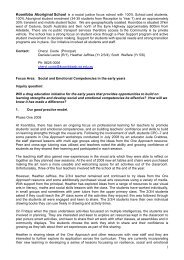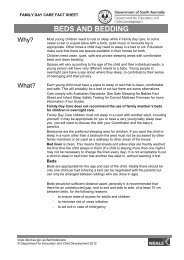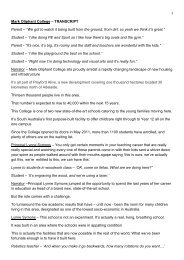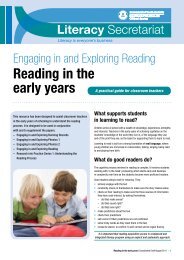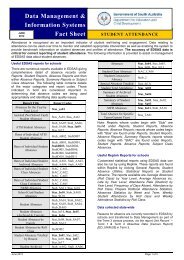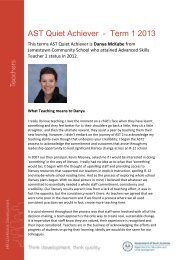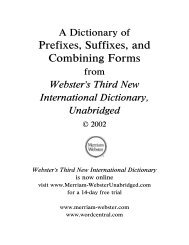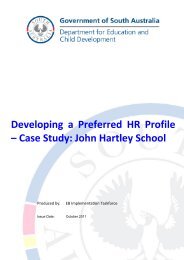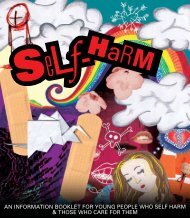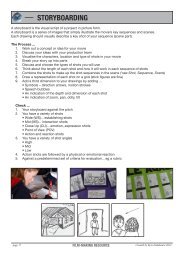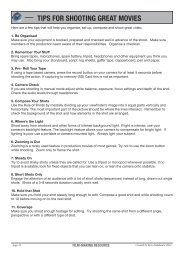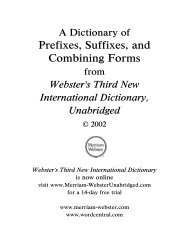Strategies that Work: Teaching Comprehension Stephanie Harvey ...
Strategies that Work: Teaching Comprehension Stephanie Harvey ...
Strategies that Work: Teaching Comprehension Stephanie Harvey ...
You also want an ePaper? Increase the reach of your titles
YUMPU automatically turns print PDFs into web optimized ePapers that Google loves.
<strong>Strategies</strong> <strong>that</strong> <strong>Work</strong>: <strong>Teaching</strong> <strong>Comprehension</strong> for Understanding and Engagement<br />
<strong>Stephanie</strong> <strong>Harvey</strong> & Anne Goudvis, second edition, Stenhouse Publishers, 2007<br />
Principles:<br />
• Active readers interact with the text – thinking needs to be made explicit and<br />
students need to develop an awareness of the their thinking<br />
• Reading involves both decoding and the making of meaning<br />
• Questions in readers, books, , reading ca cards and on worksheets tend to be the<br />
primary focus of comprehension<br />
omprehension instruction in classrooms – this approach is more about assessing<br />
comprehension than teaching students to better comprehend what they read<br />
• <strong>Comprehension</strong>s strategies are a means to an end, not an end in themselves<br />
• Both content and process are important<br />
• Explicit instruction involves shoring stud students how vs. telling them what to do<br />
Skills:<br />
• Searching for connections between what is known and new information encountered in texts<br />
• Asking questions<br />
• Drawing inferences during and after read reading<br />
• Distinguishing important from less important ideas in texts<br />
• Synthesising information within and across texts<br />
• Monitoring understanding and repairing faulty comprehension<br />
Skill levels of Readers:<br />
Tacit<br />
Readers<br />
Aware<br />
Readers<br />
Strategic<br />
Readers<br />
Reflective<br />
Readers<br />
• lack awareness of how they think when they read<br />
• realise reading has broken down but lack strategies for fixing the problem<br />
• use thinking and comprehension strategies, able to monitor and repair meaning<br />
• able to apply strategies flexibly depending on purpose for reading, reflect on thinking<br />
Effective Instruction:<br />
• Teach with the end in mind (purpose purpose, outcomes – understandings, skills, attitudes)<br />
• Plan instruction around the needs of individual students<br />
• Model use of comprehension strategies over time (including oral, written and artistic responses)<br />
• Remind students <strong>that</strong> the purpose for using a strategy is to make meaning<br />
• Apply strategies across a range of genre<br />
• Articulate how thinking helps readers better understand what they read<br />
• Model strategies as a means to an end – the goal being to build a repertoire of thinking strategies<br />
• Gradually release responsibility for using strategies with the students – teacher modelled - guided practice –<br />
collaborative practice - independent practice – application of strategy in authentic reading situations<br />
• Ensure large amounts of time are built in for text reading and talking tto<br />
o each other about the text<br />
• Use student dent data, work, talk to assess past instruction and guide future instruction
Tools:<br />
• Think alouds<br />
• Read alouds<br />
• Interactive read-alouds<br />
• Lifting text<br />
• Guided discussion<br />
• Anchor lessons and anchor charts<br />
• Re-reading for deeper meaning<br />
• Sharing our own literacy by modelling with adult literature<br />
• Text coding<br />
• Margin notes<br />
• Sticky notes<br />
• Think sheets<br />
• Response journals, note books, wonder books, personal narratives<br />
• Graphic organisers<br />
• Short text selection – range of purpose, audience, genre, topic, writing quality, text structure & features<br />
• Helping students chose text<br />
• Read, View and React (Primary Sources)<br />
• Book Club Discussions<br />
• Concept Maps<br />
• Story Maps<br />
• Stop, Think and React (Video)<br />
• Maps<br />
• Time-Lines<br />
• Exploring Current Events<br />
• Picture Dictionaries<br />
• Word Walls<br />
• Mind Maps<br />
<strong>Strategies</strong>: Strategy Lessons<br />
Making connections –<br />
text to self, text to<br />
text, text to world<br />
Questioning – before,<br />
during and after<br />
reading – questioning<br />
content, author,<br />
events, issues, ideas<br />
• Following the Inner Conversation<br />
• Noticing when we Stray from the Inner Conversation<br />
• Knowing when you Know and when you Don’t Know<br />
• Noticing and Exploring Thinking<br />
• Read, Write and Talk (STR = Stop, Think, React)<br />
• It Reminds Me of..(Code: R)<br />
• Text to Self connection (Code: T-S)<br />
• Distracting connections<br />
• Text to Text connections (Code: T-T)<br />
• Noticing and Thinking about new learning<br />
• Re-thinking Misconceptions<br />
• Building background knowledge<br />
• Text to World connections (T-W)<br />
• Literary Elements – (genre, format, form, author, text structure, signal words, writing<br />
style, literary features)<br />
• Share your Questions about your Reading (Code: ?)<br />
• The More we Learn, the More we Wonder<br />
• Some Questions are Answered, Others are Not (Code: A=answered, BK= background<br />
knowledge, I = inferred, D=discussion, RS=research, C or huh? = confused)<br />
• Gaining Information through Questioning (Questions/Facts)<br />
• Thick and Thin Questions<br />
• Reading to Answer a Question<br />
• Reading With a Question in Mind (Notes/Thinking)<br />
• Questioning <strong>that</strong> Leads to Inferential Thinking<br />
• Responding to Beyond the Line Questions in Literature<br />
• Using Question Webs to Expand Thinking
Making inferences –<br />
drawing conclusions<br />
or interpreting<br />
information not<br />
explicitly stated in the<br />
text<br />
Visualising – creating<br />
meaning through<br />
mental images<br />
Determining<br />
importance –<br />
(different to one main<br />
idea) – fiction<br />
(characters’ actions,<br />
thoughts, feelings,<br />
motives, problems)<br />
Non-fiction<br />
(remember, learn,<br />
use, evaluate<br />
information)<br />
Summarising and<br />
synthesising<br />
information –<br />
extracting central<br />
ideas, see the bigger<br />
picture – conceptual<br />
understandings,<br />
integrating<br />
information<br />
• Researchable Questions<br />
• Lingering Questions<br />
• Authentic Questions or Assessment Questions<br />
• Inferring the Meaning of Unfamiliar Words<br />
• Inferring from the Cover and Illustrations as Well as the Text<br />
• Inferring with Text Clues<br />
• Recognising Plot and Inferring Themes<br />
• Visualising and Inferring to Understand Information<br />
• Inferring and Questioning to Understand Historical Concepts<br />
• Visualising with Wordless Picture Books<br />
• Visualising from a Vivid Piece of Text<br />
• Visualising in Nonfiction Text: Making Comparisons<br />
• Visualising in Reading<br />
• Creating Mental Images <strong>that</strong> Go Beyond Visualising<br />
• Overviewing<br />
• Highlighting and Jotting<br />
• Noticing Non-Fiction Features <strong>that</strong> Signal Importance<br />
• Building Background Knowledge of Non-Fiction Features<br />
• Becoming Familiar with the Characteristics of Non-Fiction Books<br />
• Determining What’s Important When Writing Information<br />
• Making Students Aware of Primary Sources<br />
• Coding Important Information<br />
• Finding Important information (Rather than One Main Idea)<br />
• Important to Whom?<br />
• Sifting the Topic from the Details<br />
• Reading Opposite Perspectives to Form an Opinion<br />
• Using FQR Think Sheets to Understand Information<br />
• Retelling to Summarise Information<br />
• Paraphrasing to Summarise Expository Text<br />
• Synthesising: How Reading Changes Thinking<br />
• Comparing and Contrasting<br />
• Summarising the Content and Adding Personal Response<br />
• Reading for the Gist<br />
• Writing a Short Summary<br />
• Writing as Synthesis: First Person Perspective<br />
• Synthesising to Access Content<br />
• Reading Like a Writer<br />
• Trying to Understand: Seeking Answers to Questions <strong>that</strong> Have None<br />
Summarised by Debbie Draper, Curriculum Consultant, Northern Adelaide Region, 15/02/2010



